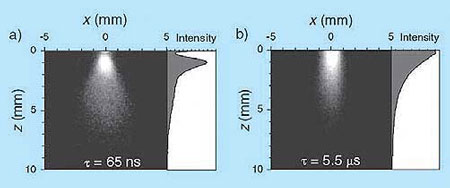| Posted: June 4, 2010 |
Generation and evolution of metal nanoparticles during utrashort LASER ablation and plasmon excitation of gold nanoparticles |
|
(Nanowerk News) The ultrashort laser ablation of solid materials is basis of different modern and advanced scientific and technological areas as fabrication of metal and semiconductor nanoparticles, deposition of nanostructures and their embedding in optical films, or deposition on their surfaces in order to alter exciting properties or development of new.
|
|
A growing scientific interest is recently focused on some specific properties of noble metal nanoparticles. The efficient excitation of plasmons in these structures, significantly influences the interaction of the electromagnetic filed and nanoparticle and contribute to appearance of new effects that are not observed in bulk materials.
|
 |
| Fig. 1. Snapshots of ablated plume at laser ablation of Ni obtained by emission spectroscopy at two time delays after the laser pulse. (a) short time delay – emission from single atoms; (b) long time delay – emissions from nanoparticles. F ? 0.8 J/cm2. z = 0 mm corresponds to the target surface.
|
|
The main results obtained on the topic are the following:
|
|
Generation and evolution of nanoparticles during ultrashort laser ablation of metals in vacuum
|
|
Novel experimental and theoretical results are obtained in the filed of clarification and explanation of the mechanisms of generation and initial evolution of nanoparticles produced during ultrashort laser ablation of metals (Al, Ni). Numerical model, based on Molecular dynamics (MD) describing the interaction of laser pulse with metal target is developed.
|
|
The experimental analyses realized on the basis of emission spectroscopy have showed that the ablated material is composed by two components – single atoms and nanoparticles (Fig. 1). The nanoparticles are formed in the stage of material decomposition as a consequence of realization of phase explosion and/or fragmentation of the overheated material.
|
|
The realization of these mechanisms can explain the experimentally observed dependences for the velocity distribution of the ablated atoms and nanoparticles, sizes and size distribution of the generated nanoparticles obtained at laser ablation at wavelengths in the UV and visible spectral range. The results indicate that the laser wavelength can be used as an efficient parameter for nanoparticles size control.
|
|
Plasmonics and surface nanostructuring
|
|
Theoretical basis of a new technique for surface nanostructuring is developed using Finite Difference Time Domain simulation technique. The proposed technique is based on the effect of field enhancement in the near field zone in vicinity of nanoparticle at condition of efficient plasmon excitation. The results indicate that the intensity of the electromagnetic field in the near field zone is significantly enhanced with respect to the incident one.
|
|
The enhancement factor is found to depend on the parameters of the incident irradiation, nanoparticles dimensions and the dielectric properties of the surrounding. This analysis can define some optimal conditions for efficient surface nanostructuring of dielectrics, semiconductors, and metals. The theoretical findings are confirmed experimentally by nanostructuring of SiO2, Si, and Au (Fig. 6, 7). The obtained results clearly indicate that the proposed method can be applied as an efficient tool for precise nanomodification of different types of materials.
|

